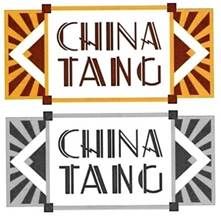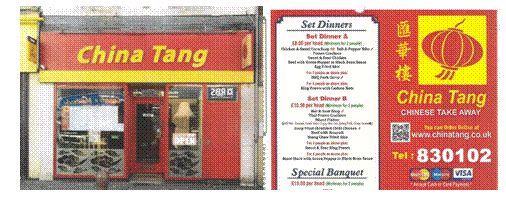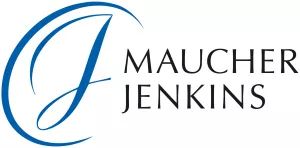- within Intellectual Property topic(s)
- with readers working within the Media & Information industries
- within Technology, Media, Telecoms, IT and Entertainment topic(s)
The Intellectual Property Enterprise Court (IPEC) has held that the CHINA TANG trade mark, used for a Cantonese restaurant called "China Tang" at the Dorchester Hotel in London, was infringed by the running of a Chinese takeaway in Barrow-in-Furness under the name "China Tang" by West Lake East Ltd (WLE).
Background
Back in 2005, GNAT and Company Limited (GNAT) registered the series mark CHINA TANG shown below for among other things, "Restaurant services; catering services; cafes; cafeterias; and self-service restaurants" in class 43:

GNAT licensed the mark to China Tang London Limited (CTL), which had run an opulently decorated Cantonese restaurant called "China Tang" at the Dorchester since 2005. In contrast, Mr Gu, the sole director and owner of West Lake East Limited (WLE), ran a Chinese takeaway in Barrow-in-Furness. WLE had started trading in 2009. Mr Gu and his wife owned the freehold in WLE's business premises and WLE had traded under the name "China Tang" at all times. Some images of the shop front and a sample menu are shown below:

GNAT and CTL alleged that Mr Gu and WLE had infringed the CHINA TANG mark. WLE and Mr Gu argued that the differences in location and style between an upmarket restaurant in Park Lane and a modest takeaway in Barrow militated against there being confusion in the real world, asserted honest concurrent use and counterclaimed for partial revocation of the CHINA TANG mark because of non-use, insofar as it was registered for "cafes; cafeterias; and self-service restaurants" (but not restaurant or catering services).
Decision
HH Judge Hacon found that the average consumer was a user or potential user of restaurant or catering services; in other words almost every adult and child in the UK. This broad characterisation applied whether or not the specification of the CHINA TANG mark included "cafes", "cafeterias", and "self-service restaurants".
GNAT and CTL agreed to delete "self-service restaurants" from the specification of the CHINA TANG mark. The judge dismissed WLE and Mr Gu's counterclaim to limit the specification of the CHINA TANG mark beyond the agreed deletion because "the average consumer would consider both a cafe and a cafeteria to be a type of restaurant". Therefore, deleting either "cafes" or "cafeterias" from the specification of the CHINA TANG mark would, by implication, limit the scope of "restaurant services" and would, in thewords of the judge, "be liable to mislead".
Due to the aural identicality of the CHINA TANG trade mark and WLE's "China Tang" sign, the close visual similarity between them and the close similarity between WLE's services and the restaurant services covered by the CHINA TANG specification (in particular, the services of low-cost restaurants which typically offer takeaway services), the judge decided that there was a likelihood of confusion.
In cross-examination, Mr Gu admitted that before choosing the name "China Tang" for his business, he had not performed a trade mark search for the name "China Tang" or an internet search for restaurants of that name. The judge took the view that even if Mr Gu had conducted a basic internet search for "China Tang", he would likely have found CTL's Park Lane restaurant website and/or reviews and commentary about it. Honest practices would then have required him to obtain legal advice about the intended trading name for his business.
Accordingly, the judge found that WLE was unable to rely on the defence of honest concurrent use, and Mr Gu was jointly liable for the acts of infringement.
Comment
This judgment reminds us that honest concurrent use will only arise in exceptional circumstances, an example being the Court of Appeal's decision that the use of "Ideal Home" for online retail services by Media 10 Ltd (the organisers of the Ideal Home Show, an exhibition which had been running since 1908) was not infringing because it was honest and had no adverse effect on the essential function of the IDEAL HOME mark, which belonged to IPC Media (the publishers of Ideal Home magazine, first published in 1920).
The case involving the IDEAL HOME mark illustrates that two businesses can use the same trade name for a long period of time, which is likely to cause a certain level of confusion amongst consumers, but that doesn't necessary amount to infringement.
However, as HH Judge Hacon noted, the proceedings involving the CHINA TANG mark were "not one of the rare cases of honest concurrent use contemplated by the Court of Appeal in IPC Media".
In this particular case, the failure of Mr Gu to check the availability of the CHINA TANG name prior to choosing it for his business proved fatal, with the judge of the clear view that size does not matter:
"... had the defendant been a large enterprise with a trade mark department which diversified by opening a single takeaway in Barrow and which failed to conduct a trade mark search, it would be hard not to conclude that this failure was not in accordance with honest practices absent good reasons for the failure. That would remain true even if the failure was negligent rather than deliberate. I can see no principled reason for a cut-off related to the size of the enterprise below which such a failure remains in accordance with honest practices. Setting up even the smallest business is likely to require competent legal advice on a variety of matters and that should include the trading name. A public register of other parties' rights is there to be consulted, in part so that those rights may be respected."
Case citation: GNAT and Company Ltd & Anor v West Lake East Ltd & Anor [2022]EWHC 319 (IPEC) (16 February 2022)
Our full article on this case appears in Entertainment Law Review: please click here for link to abstract on Westlaw.
The content of this article is intended to provide a general guide to the subject matter. Specialist advice should be sought about your specific circumstances.


